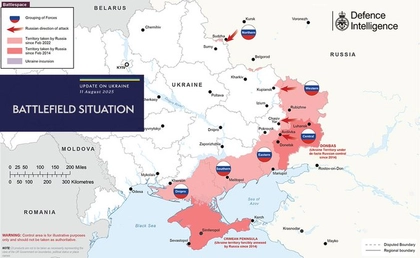The Russian and Ukrainian air forces have traded air strikes across the front over the past week, in an intensification of air combat that for most of the war has been heavily in favor of Kremlin airmen.
Russian strike aircraft, since Aug. 4, kept to a long-established pattern of targeting Ukrainian frontline positions along with civilian infrastructure, using long-range glide bombs launched from outside the range of most Ukrainian air defenses, a Ukrainian army statement said.
JOIN US ON TELEGRAM
Follow our coverage of the war on the @Kyivpost_official.
Ukrainian bombers – most reportedly Soviet-era MiG-29 or Su-27 fighter jets reconfigured to drop NATO-standard munitions – in a rare uptick of counterstrikes of their own, over the past week, focused on Russian headquarters spotted near the fighting lines. There was some evidence that the Ukrainian Air Force strike planners were also trying to target Russian drone pilots.


Other Topics of Interest
British Ministry of Defence Update on Ukraine Aug.11
Latest from the UK Ministry of Defence.
The highest-profile and most-attacked Russian target was a bridge inside the city of Kherson connecting residential and administrative districts of the city to a low-lying industrial district fronting the Dnipro River.
A single Russian bomb reportedly weighing three tons struck the bridge on Saturday, Aug.2, punching an automobile-size hole in the pavement but leaving the rest of the structure mostly undamaged. At least five separate air strikes since then have attempted to hit the bridge again and bring it down.
Those attacks missed the bridge and struck nearby, causing heavy damage to homes and businesses, and shutting down gas, water, and power services in the neighborhood, the Kherson regional administration stated Thursday.
A Russian air strike hitting an outlying town in the adjacent Zaporizhzhia sector on Wednesday killed two civilians, injured nine, and damaged nine buildings. On Sunday, at least two Russian glide bombs struck a bus station and a university clinic inside the major city of Zaporizhzhia. Twenty civilians were injured but none killed, Governor Ivan Federiv said in a statement.

According to reports from Ukraine’s General Staff of the Armed Forces, Russia dropped between 92 and 160 guided aerial bombs per day on Ukrainian territory in early August 2025. Ukrainian strikes by manned aircraft are always rare, and in some weeks don’t take place at all.
But the week of Aug. 4-11 saw a – for Ukraine’s tiny air force – surprisingly robust effort to hit back, although Ukrainian airmen are probably outnumbered by their Russian opponents at least ten to one, based on open-source estimates of available combat aircraft.
A Ukrainian Army General (AGS) Staff statement published on Sunday said an air force strike jet bombed a Russian army battalion headquarters in the vicinity of the occupied town of Oleshki, in Ukraine’s southern Kherson region.
The munitions killed “around 25 occupiers” and wounded 11 more Russian service personnel, the official statement said, citing army intelligence.
Among the Russian officers killed were the battalion commander, the commander of the battalion’s engineer troops, and a platoon commander, the statement said. Ukrainian milbloggers confirmed the fact of the strike and Russian casualties.
According to unconfirmed reports, a Ukrainian Air Force MiG-29 jet dropped a pair of US-made GBU-62 glide bombs to make the attack. The Ukrainian milblogger Soniashnyk published video showing two bombs detonating in an industrial region, later geo-located to the Oleshki district.
The GBU-62 JDAM-ER bomb is a guided air-dropped munition first received by the Ukrainian military in 2023. A glide bomb opens its wings after the aircraft releases it. The precision-guided munition flies to the target using GPS and inertial guidance.
A Ukrainian army video published on Friday showed an air strike hitting buildings claimed by Kyiv to have been a Russian unit headquarters in the northern Kharkiv region. Some milbloggers reviewing images said the munitions dropped were American GBU-39 bombs, a smaller version of the GBU-62. The video showed lower-order explosions consistent with a weapon of that size, but independent confirmation of the claimed strike location wasn’t possible, a Kyiv Post review found.
Ukrainian media widely confirmed a Ukrainian Air Force strike using a French AASMS guided glide bomb in the town of Kamyanske, Zaporizhzhia region, on Wednesday, against a headquarters. Geo-located video showed a pair of direct hits. Some reports said the aircraft used was an F-16 jet dropping a GBU bomb or bombs.
Over the week, unconfirmed text and video evidence of individual Ukrainian Air Force strikes also hitting in the eastern Pokrovsk and southern Kherson region appeared on Ukrainian military information platforms.
Source link

